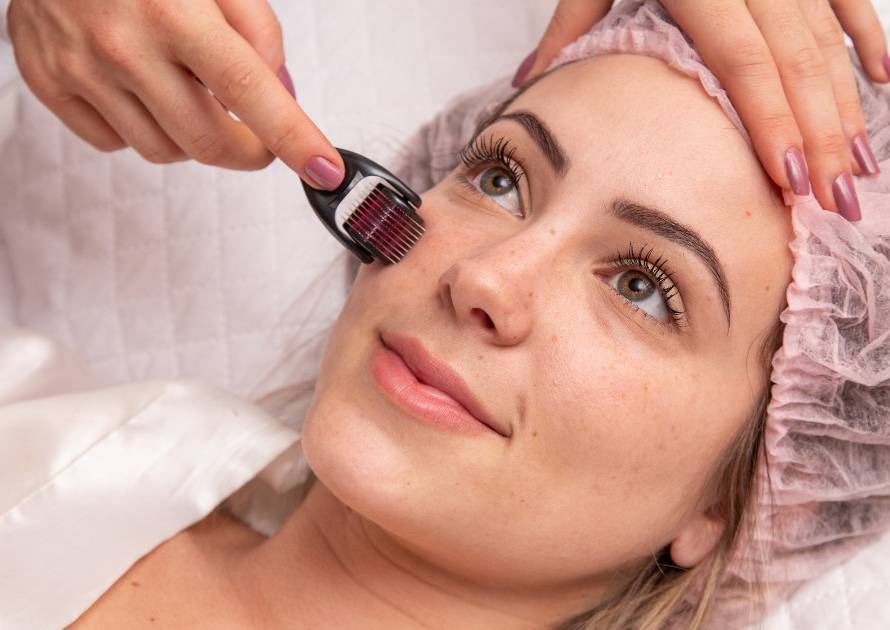Chemical peeling procedures use a chemical solution to remove damaged layers of skin, revealing the healthier skin underneath. A chemical peel can reduce or improve many skin problems like fine lines, wrinkles, acne, scars, pigmentation, and more. The type of chemical peel used depends on the depth of your peel and the type of skin condition treated.
What Is Chemical Peeling?
Chemical peeling, also known as chemexfoliation or derma peeling, is a procedure done at home or at the clinic by an experienced doctor to remove the superficial layer of skin in variable depths depending on the skin condition and area treated.
During this procedure, a chemical solution is applied to your skin, which causes trauma or injury to your skin’s layers. The injured skin then peels off, revealing healthier, more youthful skin. Usually, the new skin is smoother, is brighter in complexion, has fewer lines and wrinkles, and has a more even color to it.
It is important to understand that chemical peels are not magical treatments. Multiple sessions might be needed with a number of topical creams to be used at home. It is essential to allow the skin to properly heal by following the doctor’s instructions after the chemical peeling procedure.
There are many types of chemical peeling, different materials used, and different durations of time for the procedure depending on the aforementioned factors. Some solutions are left on the skin for seconds, while others are left for hours. So far, chemical peeling can be used on the face only as there is not enough research and evidence that it can be used on the body. If chemical peeling is used on the body without caution, the patient will be at a higher risk for paradoxical hyperpigmentation.
Types of Chemical Peeling
There are three different types of chemical peeling, each used for a certain range of skin conditions. These types include:
- Superficial (light) chemical peeling: Superficial chemical peeling removes the top layer of skin (epidermis). This type is usually used to treat fine lines, wrinkles, acne, uneven skin tone, and dryness. You can have a superficial chemical peeling session every two to five weeks.
- Medium chemical peeling: Medium chemical peeling removes skin cells from the epidermis and from portions of the upper part of the middle layer of skin (dermis). It’s used to treat wrinkles, acne scars, and uneven skin tone.
- Deep chemical peeling: Deep chemical peeling removes skin cells in the deeper layers of the skin. This type of chemical peeling is usually used to treat deeper wrinkles, scars, or precancerous growths.
Why Chemical Peeling Is Done
There are many skin conditions that chemical peeling can treat, including improving your skin appearance and rejuvenating damaged skin by improving the tone and texture of your skin. It is usually preferred to use chemical peeling on the skin of your face, neck, or hands only. This is what chemical peeling can help improve or reduce:
- It can help unify the skin’s color and lighten pigmented areas.
- It can help reduce fine lines under your eyes and around your mouth and wrinkles caused by sun damage, age, or genetics.
- It can help rejuvenate the damaged and aged skin.
- It can help treat mild scarring.
- It can treat certain types of acne.
- It can help treat sun spots, age spots, liver spots, freckles, and uneven skin coloring.
- It can help treat actinic keratosis, which is precancerous scaly spots.
- It can help treat tough skin, scaly patches, and dull complexion.
- It can help treat dark patches (melasma) due to pregnancy or taking birth control pills.
You need to get checked by a dermatologist so they can assess your skin’s condition and area that should be treated, and depending on it, determine the depth of your chemical.
Risk Factors of Chemical Peeling
The chemical peeling procedure can cause several side effects, including:
- Redness and irritation: Healing from a chemical peel usually involves redness of the treated skin that lasts for a few hours to a few days. After a medium or deep chemical peel, redness might last for a few months.
- Swelling: It is normal for swelling to occur for a few hours to days after the chemical peeling procedure.
- Pain: The pain from chemical peeling is usually tolerable, and patients do not complain much about it.
- Paradoxical hyperpigmentation: Chemical peeling can sometimes cause treated skin to become darker than normal (hyperpigmentation). Hyperpigmentation is more common after superficial peels.
- Bacterial of Viral Infections: Chemical peeling can sometimes lead to a bacterial, fungal, or viral infection.
- Scarring and hypopigmentation with severe reaction: This is especially common after a deep chemical peeling. Hypopigmentation is when the skin becomes lighter than normal.
How the Chemical Peeling Procedure Is Done
This is what you can expect to happen during the chemical peeling procedure:
- First, the doctor will clean the area that is to be treated.
- Then, the doctor will protect certain areas, like the lips, under the eye, the corner of the mouth, and the nose, by applying a barrier.
- The doctor will then apply the chemical peel material to the targeted area.
- The duration in which the chemical peel substance stays on the area varies according to the material used.
- The doctor will keep watching the area while looking out for a severe reaction like excessive erythema, burning sensation, or frosting.
- Next, the doctor will remove the chemical peel by wiping it or by adding a buffer with certain peels.
- Finally, the doctor will apply healing cream and sunblock to the treated area.
What to Expect and Do After the Chemical Peeling Procedure
Here’s what you can expect to happen after the chemical peeling procedure, in addition to a few instructions from the doctor on what to do to maintain the best results possible.
- During the first two days following the peeling, there will be darkening and dryness in the treated area.
- The peeling usually starts on the third day, and it can last up to two weeks.
- Apply healing cream as much as possible.
- Try to stay away from the sunlight as much as possible.
- Avoid friction or itching.
- Avoid the temptation to peel the dry skin and let it peel by itself.
- Wash the area with water daily.
- Avoid long, hot baths or overheating the skin.
- Avoid wearing makeup products in the first week after peeling.
Frequently Asked Questions About Chemical Peeling (FAQs)
This section aims to shed light on the most commonly and frequently asked questions regarding the chemical peeling procedure.
Is there downtime after the treatment?
There isn’t downtime after a superficial (light) chemical peeling. However, you will have downtime after a medium or deep chemical peeling. A deep chemical peel requires recovery at home for 2 to 3 weeks.
When will I see the results?
Once your skin heals, you will see the results of the treatment. Usually, healing time takes from 1 day for a lunchtime peel to 14 days or longer for a deep peel. To get the results you seek from a lunchtime (superficial) peel, you may need to have 3 to 5 peels.
How long will the results last?
The results will most likely not be permanent because your skin will naturally continue to age. If you have lots of sun-damaged skin, you will most likely still see new spots and growths on your skin. You will need to have a few more sessions of chemical peeling before you reach the desired results.
When is it safe to have another chemical peel?
Our dermatologist, Dr. Maha Marji, does not recommend that you do any chemical peeling before a month passes after your first chemical peeling session. To stay safe, it is better to follow the doctor’s advice and instructions.
Is it safe to exercise after the peel?
It is better to avoid exercise that produces a lot of heavy sweating on the day of the peel. You may resume all regular activities the next day.
How long do chemical peels take?
Most peels are performed in less than one hour, depending on the size of the area being treated. In our clinic, the chemical peel takes from 20-30 minutes maximum.
How many peels will I need?
The superficial peels are usually done several times over the course of several months. Regardless of the technique, you will likely need repeat treatments. You need to consult your doctor to get a definite answer on the number of sessions you might need.



